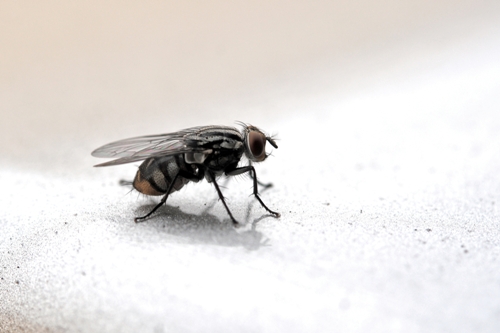Why Control Canadian Flies?
Because flies live in varied habitats, they often come into contact with humans. Flies carry many different diseases that humans can get from them. These include:
- Cholera
- Dysentery
- E. coli
- Hepatitis
- Salmonella
- Staphylococcus
- Shigella
- Typhoid fever
Without proper fly control all humans and animals are put at risk.
To control the flies we must first understand the life cycle of a typical fly.
The majority of flies in Canada fall into four types: Drain, Fruit, House, and Phorid-Humpbacked Fly. Each category may have a slightly different life cycle when it comes to timing, but they all have the same progression.
- Egg
- Larva (Maggot)
- Pupa
- Adult
Flies complete their entire life-cycle within a few weeks. The environment plays a big role in the length of the fly’s life cycle. The cold lengthens their life and heat shortens it.
Five of the most proven ways to control flies
The most common places flies lay their eggs are the trash, house plants, fruit, and drainpipes. The first line of defence is to keep these items in check.
1. Recycling is key

Recycle as much of your garbage as possible: this will keep flies from the trash. As you consume your goods be sure to rinse your recyclables before you throw them out. Keep compost outdoors in a container designed for the job. By recycling and composting you will have less actual garbage and fewer flies making their home in your trash can.
2. Proper Storage of Fruits and Vegetables
Keeping your ripe fruit stored properly rather than simply lying out on the countertop will curtail fruit flies. As soon as you bring your fruit home, wash it thoroughly so that any flies or eggs already on the fruit will be removed.
3. Watch the drains in the house
Flies like to lay their eggs in dark, damp areas which means drains are prime real estate. Keep your drains free of trash and covered with a well fitting stopper when they are not being used.
4. Choose the right combination of houseplants for your home
Bringing plants into the home such as citronella, citrosa geranium, and lemon verbena will help repel flies. They do not kill them but by mixing them in with your houseplants you are less likely to have flies. Flies do not like basil. If you keep a basil plant, pick leaves and put them in areas where flies are prevalent.
5. A homemade fly trap can help to capture adults before they lay their eggs.
Place apple cider vinegar into a glass and then cover the glass tightly with plastic wrap. Once covered, use a toothpick or straight pin to prick tiny holes into the plastic. The vinegar will attract the flies and they will be trapped under the plastic wrap. Once your vinegar is full of flies, take outside to dispose of them.
In some cases you may need to seek professional services to rid your surroundings of flies. In these cases call JDM Pest Control. JDM Pest C offer’s service calls and are quick to respond. Give us a call at 416-729-3568 for a free assessment.
